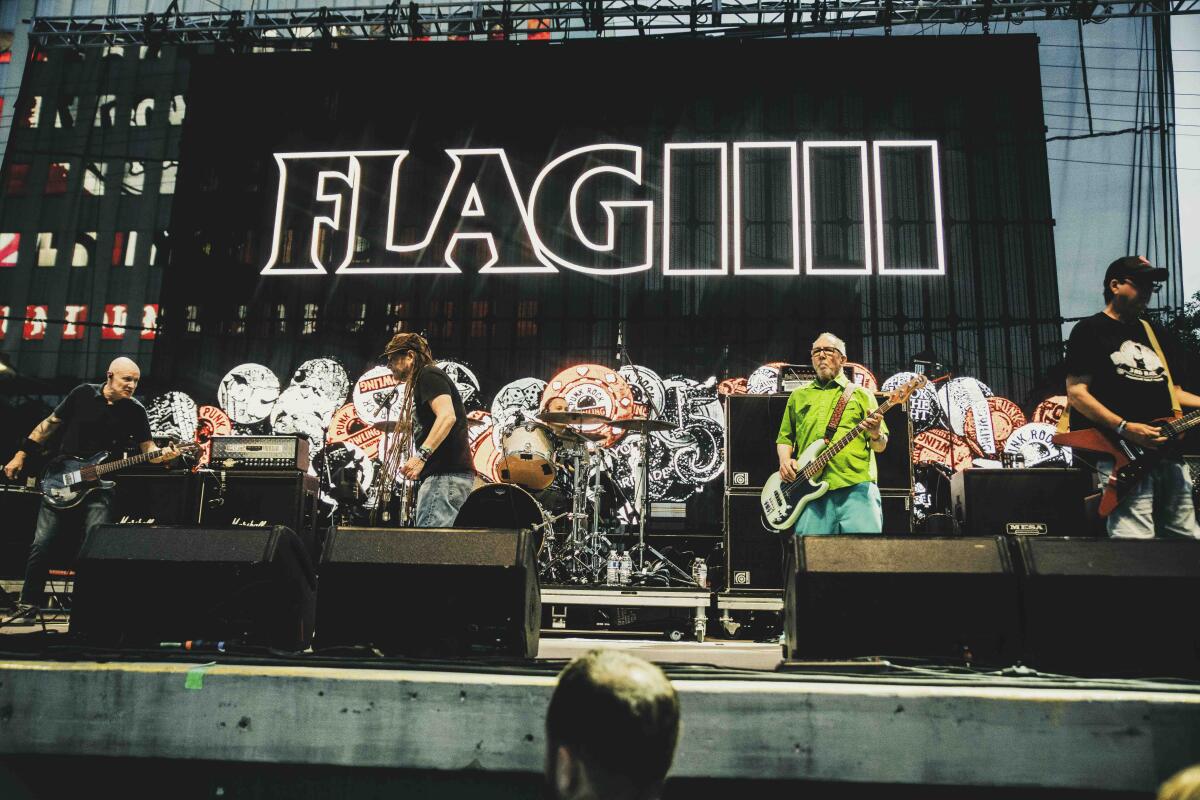FLAG once again proves that not all punk band reunions are created equal

- Share via
There was something in the air at Punk Rock Bowling in Las Vegas last weekend.
No, it wasn’t the sound of distorted guitars, punk rockers puking or Nazis getting punched in the face. Though there was plenty of all of that.
It was the buzz surrounding FLAG, the most talked about band at the annual bowling tournament and music festival, now in its 25th year.
FLAG is the hardcore supergroup composed of four former members of Black Flag — Keith Morris, Chuck Dukowski, Dez Cadena, and Bill Stevenson — and Stephen Egerton, Stevenson’s longtime bandmate in the Descendents.
It had been six years since the last FLAG gig, which was also at Punk Rock Bowling. But this was more than a reunion show. It felt like history in the making.
It started Saturday with a panel discussion led by Fat Mike of NOFX at the Punk Rock Museum. Surrounded by photos of their younger selves taken by the late Naomi Petersen, all five members answered questions from Fat Mike, who introduced FLAG as “the best version of Black Flag I’ve ever seen.”
Fat Mike asked each participant to name their favorite album or song, which became something of a referendum on the band’s volatility on and off the stage, with musicians cycling in and out of the band. For instance, Henry Rollins, the band’s best-known vocalist, was Black Flag’s fourth singer.
“When people say, ‘Oh, Henry is my favorite. Ron [Reyes] was my favorite,’” Cadena said, “usually, that’s the first gig that they saw.”
“Why is it a contest?” Morris asked. “Each one of us contributed in the way we contributed. We each had our own personality.”

That those personalities frequently clashed with the band’s enigmatic guitarist and songwriter Greg Ginn is the story of Black Flag. Extreme music attracts extreme people. What’s unusual about these clashes is that they continued long after Ginn pulled the plug on his own band in 1986.
For instance, in June 2003, Rollins and Morris played Black Flag songs together — just not at the same time, Morris clarified during the panel — to raise money and awareness for the West Memphis 3.
It’s probably not a coincidence that later that summer, Ginn put together a Black Flag reunion of sorts at the Hollywood Palladium. The problem?
It featured musicians who’d never been in the band and they played along to prerecorded bass tracks. The shambolic set wasn’t well-received. These shows were also a benefit — for cats — launching a veritable cottage industry of CAT FLAG T-shirts.

In December 2011, Morris, Dukowski, Stevenson and Egerton played together for the first time at the Goldenvoice 30th anniversary show at the Santa Monica Civic Auditorium, where they were introduced as “Black Flag.”
The old friends had such a blast playing together, they decided to keep it going. Cadena was added to the mix and they played Black Flag songs under the banner of FLAG. The coming-out party for this lineup was an incendiary set at the Moose Lodge in Redondo Beach in April 2012.
Again, it’s probably not a coincidence that Ginn subsequently “reunited” Black Flag and initiated all kinds of legal activity against his former bandmates. At the heart of the issue was who could use the names FLAG and Black Flag. At the end of the day, the courts ruled that FLAG could continue.
Mike Magrann, vocalist and guitarist for L.A. punk band Channel 3, saw both bands play that year.
“It was puzzling,” Magrann said of Black Flag’s set, “because they weren’t honoring their legacy. When FLAG played, they played those songs the way they sounded back then. It brought back that feeling of being a kid on the side of the pit. The real threat of violence is right there. It was unbelievable!”
That ineffable feeling of danger is what drew so many people to FLAG’s Memorial Day performance. Fans came from all over the world just to see the show. Joey Cape of Lagwagon wrapped up a solo tour in Japan and flew directly to Punk Rock Bowling.
Like Cape and Magrann, some of the most hardcore fans were musicians who’d been inspired by Black Flag when they were young. David O. Jones of Carnage Asada drove in from L.A. with Martin Wong, who organized Save Music in Chinatown, and Martin’s daughter, Eloise Wong of the Linda Lindas. They returned to L.A. immediately after the show because Eloise, who is a junior in high school, had a physics test the following morning.
FLAG made it worth the trip. The band ripped through 22 songs, starting with “Revenge” and mixing crowd favorites like “My War” with deep cuts such as “Clocked-In.” Morris held the microphone with both hands like he was blowing on a bugle and urging the crowd to charge.
It was easily the rowdiest pit of the festival, and it swelled to nearly the length of the stage with a steady stream of crowd surfers being passed over the barricade: old men, young women and even small children. During songs like “Gimme Gimme Gimme,” “Wasted” and “Nervous Breakdown,” the roar from the crowd was almost as loud as the band.
There wasn’t any banter from the usually loquacious Morris. Toward the end of the show, he simply said, “Thank you for your participation,” and launched into the next song.

After the obligatory performance of “Louie Louie” at the end of the set, the players took their instruments off the stage and were gone. Fans young and old looked at each other in disbelief, their lives changed, their DNA forever altered by punk rock.
FLAG had done it again. They played the songs the way they were meant to be played. They honored their legacy.
It will be a tough act for Black Flag to follow. In recent years, Black Flag has been much more active. Inevitably, that means more changes to the lineup. Earlier in May, Ginn announced Black Flag will be touring Europe this summer with three new members: all of them young musicians, including a young woman named Max Zanelly as the new vocalist.
Once again, the internet flooded with Black Flag memes keying on the considerable age gap between Ginn, who is 70, and his new bandmates who look many decades, if not generations, younger. Wong, who knows something about the power of young musicians to change the world, is hopeful.
“Everyone wins when there’s more good music in the world,” Wong said. “In a perfect world, the new Black Flag lineup will get Ginn stoked on music and push him forward. But if that doesn’t happen, we get FLAG, the best Black Flag lineup that never happened.”
While Black Flag prepares for its new chapter, is this the end of the road for FLAG?
“I don’t know,” Stevenson said after the panel at the Punk Rock Museum. “We always have fun when we get together. You can tell we love each other. I’m sure we’ll do more. At some point, one of us will be too old to do it, but so far that’s not the case.”
Jim Ruland is the author of the L.A. Times bestselling book “Corporate Rock Sucks: The Rise & Fall of SST Records” and a weekly Substack about books, music, and books about music called Message from the Underworld.
More to Read
The biggest entertainment stories
Get our big stories about Hollywood, film, television, music, arts, culture and more right in your inbox as soon as they publish.
You may occasionally receive promotional content from the Los Angeles Times.












